Send this page of Saint Patrick's floats and bands to a
friend

Saint Patrick's Day
parade
Jackson, Mississippi
Floats and bands
|
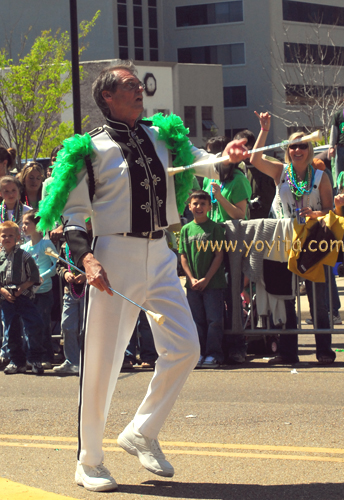 |
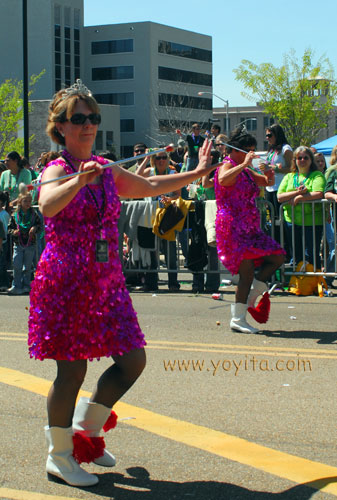 |
| |
|
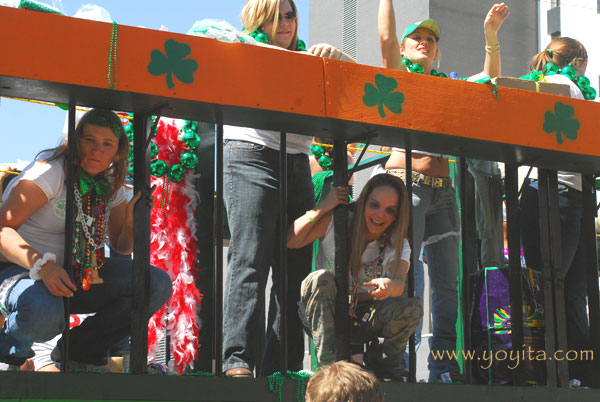 |
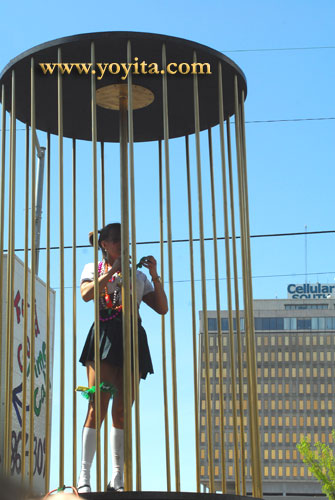 |
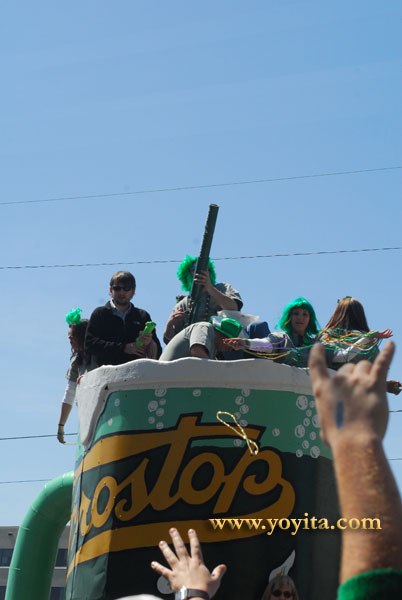 |
| |
|
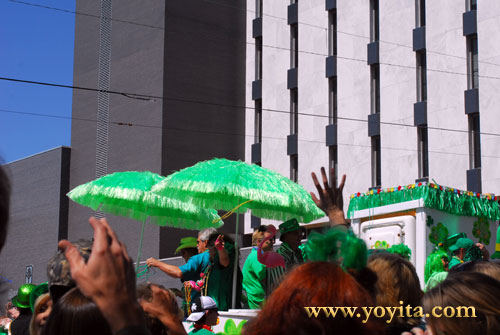 |
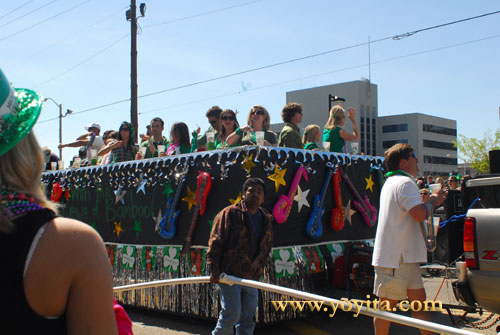 |
| |
|
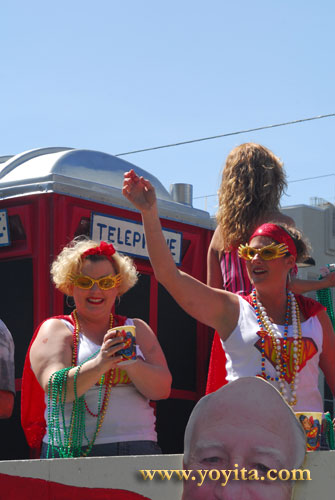 |
|
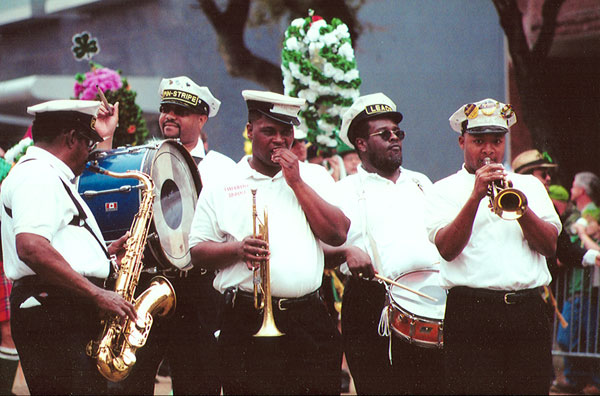 |
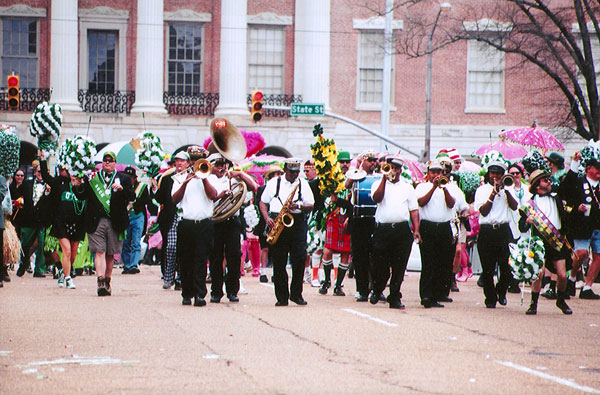 |
|
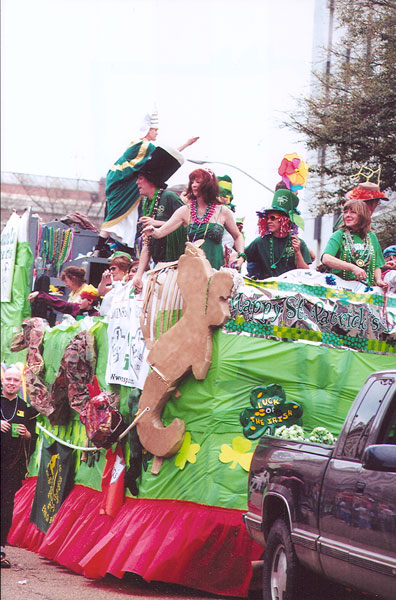 |
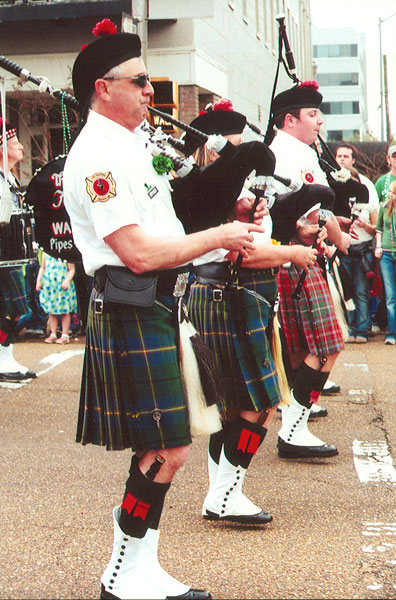 |
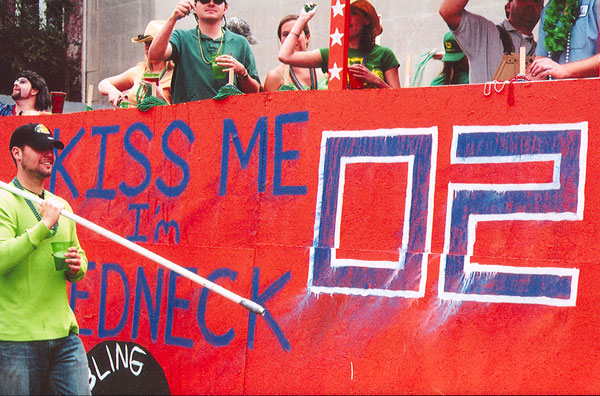 |
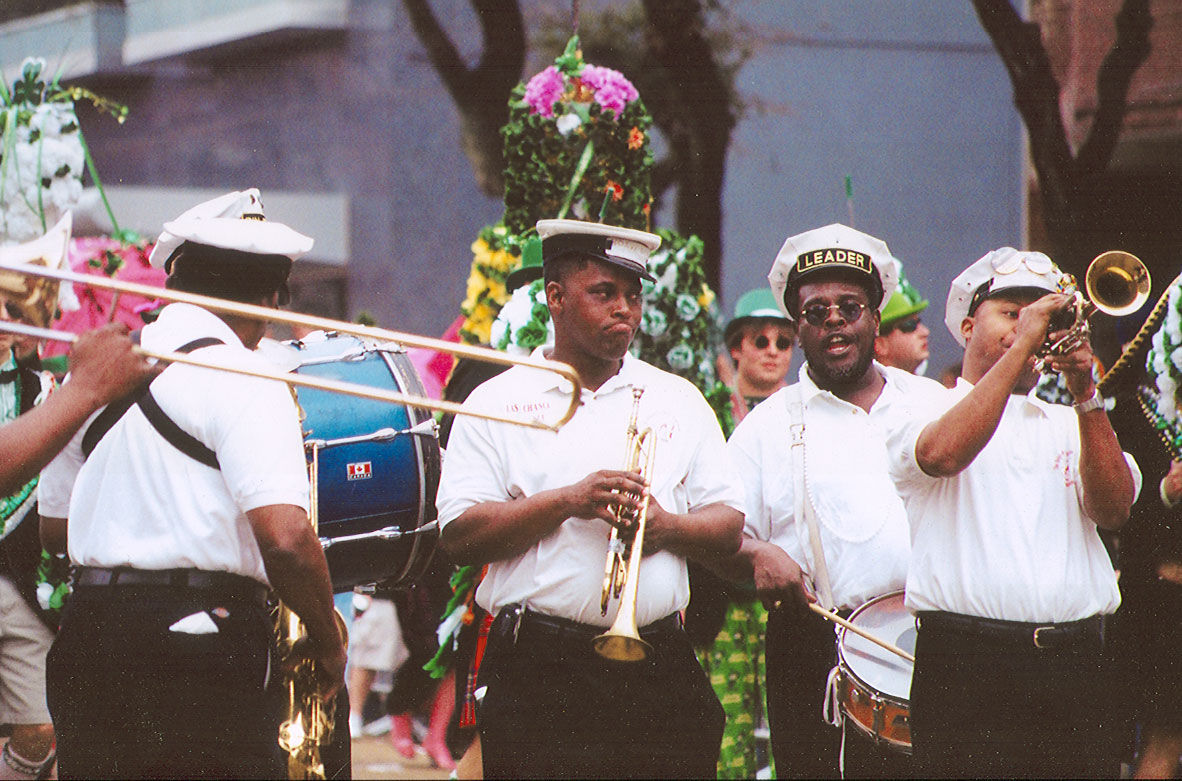 |
|
|
|
|
Saint Patrick's Day
(March 17), is the Irish feast day which celebrates Saint Patrick (386-461), the patron saint of Ireland. It is a legal holiday in the Republic of Ireland, Northern Ireland, the overseas territory of Montserrat and the province of Newfoundland. It is celebrated worldwide by the Irish and those of Irish descent (and increasingly by many of non-Irish descent). A major parade takes place in Dublin and in most other Irish towns and villages. The four largest parades of recent years have been held in Dublin, New York City, Manchester, and Savannah. Parades also take place in other places, including London, Paris, Rome, Munich, Moscow, Beijing, Hong Kong, Singapore, Copenhagen and throughout the Americas.
As well as being a celebration of Irish culture, St. Patrick's Day is a Christian festival celebrated in the Roman Catholic Church, the Church of Ireland (among other churches in the Anglican Communion) and some other denominations. However, as a Christian festival, St. Patrick's Day sometimes is required to give way to a more important feast. The day always falls in the season of Lent, and it may fall in Holy Week. In church calendars, though rarely in secular ones, if St. Patrick's Day falls on a Sunday, it is moved to the following Monday. If it falls in Holy Week, it is moved to the second Monday after Easter. In Ireland it is traditional that those observing a lenten fast may break it for the duration of St. Patrick's Day.
Celebrations in Ireland
St. Patrick's Day parades in Ireland date from the late 19th century, originating in the growing sense of nationalism of the period.
In the mid-90's, a group called St. Patrick's Festival was set up by the government with the aim to Offer a national festival that ranks amongst all of the greatest celebration in the world Create energy and excitement throughout Ireland via innovation, creativity, grassroots involvement, and marketing activity.
Provide the opportunity and motivation for people of Irish descent (and those who sometimes wish they were Irish) to attend and join in the imaginative and expressive celebrations Project, internationally, an accurate image of Ireland as a creative, professional and sophisticated country with wide appeal, as we approach the new Millennium.
The first St. Patrick's Festival was held in 1996, and was celebrated only on the day. In 1997, it became a three day event, and since 2000 has been a 4 day event. The most recent Festivals have encompassed spectacular fireworks displays (Skyfest), open-air music, street theatre and the traditional parade.
The topic of the previous year's (2004) St. Patrick's Symposium was "Talking Irish," during which the nature of Irish identity, economic success and the future was discussed. Since 1996, there has been a greater emphasis on celebrating and projecting a fluid and inclusive notion of 'Irishness' rather than a fixed identity based around traditional religious or ethnic allegiance. Nevertheless, many Irish people still wear a bunch of shamrock on their lapels or caps on this day, while children wear tri-colour (green, white and orange) badges. Girls traditionally wore green ribbons in their hair (many still do).
The biggest celebrations in Ireland outside Dublin are in Downpatrick, where Saint Patrick was buried following his death on March 17, 461. In Downpatrick in 2004, according to Down District Council, the parade, during the week-long St. Patrick's Festival, had over 2000 participants and 82 floats, bands and performers. The parade was watched by over 30,000 people.
Although celebrated by the Church of Ireland as a Christian festival, St. Patrick's Day as a celebration of Irish culture is rarely acknowledged by British loyalists in Northern Ireland, who consider it a republican festival. Belfast City Council recently agreed to give some funding to its parade for the first time. Previously the parade was privately funded.
Celebrations outside Ireland
The smallest parade is said to take place in Hot Springs, Arkansas in the United States; this parade is less than a single city block and is nevertheless the highlight of the day. Boulder, Colorado claims to have the shortest parade which is also less than a single city block.
The first civic and public celebration of St. Patrick's Day in the American Colonies took place in Boston in 1737. The first St. Patrick's Day celebrated in New York City was held at the Crown and Thistle Tavern in 1756. Since then the New York celebration has become the largest St. Patrick's Day parade in the world. The parade itself dates back to 1762, and in 2003 more than 150,000 marchers participated, including bands, military and police groups, county associations, emigrant societies, social and cultural clubs. The parade marches up 5th Avenue in Manhattan and it attracts roughly 2 million people.
The New York parade has been dogged with controversy in recent years as its organisers have banned Irish gays and lesbians from marching as a group. Gay rights groups have fought in court to obtain the right to march alongside other organizations, and there have been calls in Ireland (which, since 1992, has some of the most liberal gay laws in the world) for a boycott of the parade. The gay groups and their sympathisers would lie down in the middle of the street at the start of the parade route, and would be arrested when they refused to move; in the late 1980s such arrests averaged several hundred per year, but had dwindled to a dozen or less annually by the early 2000s. A tradition has begun in Queens, New York of organizing a parade the week before the official St. Patrick's Day parade which is open to all organizations wishing to march.
The parade is organized and run by the Ancient Order of Hibernians (AOH) [1]. For many years, the St. Patrick's Day Parade was the primary public function of the AOH. On occasion the AOH has appointed controversial Irish republican figures (some of whom were barred from the U.S.) to be its Grand Marshal.
The New York parade is moved to the previous Saturday (March 16) in years where March 17 is a Sunday. The event is also moved on the rare occasions when, due to Easter falling on a very early date, March 17 would land in Holy Week—this last occurred in 1913, when the parade was held on Saturday, March 15 because Easter that year was March 23 (making March 17 the Monday of Holy Week); this same scenario is scheduled to arise again in 2008, when Easter will also fall on March 23. In many other American cities (such as San Francisco), the parade is always held on the Sunday before March 17, regardless of the permutations of the liturgical calendar.
The Chicago River, dyed green for the 2005 St. Patrick's Day celebration.Some U.S. cities paint the traffic stripe of their parade routes green. Others, including Chicago, dye their principal rivers green, an act that most native Irish find bizarre.
The longest running St. Patrick's Day parades in the U.S. are:
Boston, Massachusetts, since 1737
New York, New York, since 1762
Philadelphia, Pennsylvania, since 1780
Savannah, Georgia, since 1813
Carbondale, Pennsylvania, since 1833
Chicago, Illinois, since 1843
New Haven, Connecticut, since 1845
San Francisco, California, since 1852
The longest running St. Patrick's Day parade in Canada takes place in Montreal, which began in 1824. |
Saint Patrick's day Parade Floats Copyright 1976-2007 Dr. Gloria M. Norris.
Click
 to contact the artist for prices or information to contact the artist for prices or information
|
Ridgeland, Neshoba county, Mississippi, symbols, emblems, flag, seal, state, Berverage, Milk, Bird, Mockingbird, Fish, Largemouth, Black, Bass, Micropterus,salmoides, Fossil, Prehistoric, Whale, Flower, Magnolia, Insect, Honeybee,Apis, mellifera, Mammal, Land, White-tailed, white, tail, deer, Odocoileus, virginianus, Mammal,Water,Bottlenose, Dolphin, Tursiops, truncatus, Shell, Oyster, Crassostrea, virginica, Song, Go, Mississippi, portrait, Eudora Welty, Mississippi, Writers, ponder heart, why I live at the PO, parade, Mississippi, Writers, Authors, Literature, South, Eudora Welty, Jackson, Ponder Heart, Delta Wedding, Golden Apples, Worn Path, Petrified Man, Robber Bridegroom, Wide Net, Fiction, Stone,Petrified,Wood,Tree, Choctaw, portrait, artists, painters, atelier, american society of portrait artists, museum, Universities, Gallery, galleries, home comming,ASOPA, Adams County, Alcorn County, Amite County, Attala County, Benton County, Bolivar County, Calhoun County, Carroll County, Chickasaw County, Choctaw County, Claiborne County, Clarke County, Clay County, Coahoma County Copiah County, Covington County, DeSoto County, Forrest County, Franklin County, George County, Greene County, Grenada County, Hancock County, Harrison County, Hinds County, Holmes County, Humphreys County, Issaquena County Itawamba County, Jackson County, Jasper County, Jefferson County, Jefferson Davis County, Jones County, Kemper County Lafayette County, Lamar County, Lauderdale County, Lawrence County, Leake County, Lee County, Leflore County, Lincoln County, Lowndes County,Madison County, Marion County, <Marshall County, Monroe County, Montgomery County, Neshoba County, Newton County, Noxubee County, Oktibbeha County, Panola County, Pearl River County, Perry County Pike County, Pontotoc County, Prentiss County, Quitman County, Rankin County, Scott County, Sharkey County, Simpson County, Smith County, Stone County, Sunflower County, Tallahatchie County, Tate County, Tippah County Tishomingo County, Tunica County, Union County, Walthall County, Warren County, Washington County, Wayne County Webster County, Wilkinson County, Winston County, Yalobusha County, Yazoo County traditional, sculpture, bust, busts, representation, depiction, represent, landscapes, pastels, watercolors, still life, drawing, drawings, cartoons, digital, animals, wild life ,painting secrets,ney york, manhattan art, award winning, masters, William Merritt Chase, Cecelia Beaux, John Singer Sargent, painting, corporate, religious, religion, masterpieces, portraiture,painting, contemporary art, National Portrait Gallery, mississippi art, The South, legacy, daguerrotype, inheritance, heir, heritage, patrimony, image, picture, Mississippi museums, mississippi fine art, mississippi gallery, Abbeville town, Aberdeen city, Ackerman town, Algoma town, Alligator town, Amory city, Anguilla town, Arcola town, Artesia town, Ashland town, Baldwyn city, Bassfield town, Batesville city, Bay Springs city, Bay St. Louis city, Beaumont town, Beauregard village, Belmont town, Belzoni city, Benoit town, Bentonia town, Beulah town, Big Creek village, Biloxi city, Blue Mountain town, Blue Springs village, Bolton town, Booneville city, Boyle town, Brandon city, Braxton village, Brookhaven city, Brooksville town, Bruce town, Bude town, Burnsville town, Byhalia town, Caledonia town, Calhoun City town, Canton city, Carrollton town, Carthage city, Cary town, Centreville town, Charleston city, Chunky town, Clarksdale city, Cleveland city, Clinton city, Coahoma town, Coffeeville town, Coldwater town, Collins city, Columbia city, Columbus city, Como town, Corinth city, Courtland town,Crawford town, Crenshaw town,Crosby town,Crowder town, Cruger town, Crystal Springs city, D'Iberville city, D'Lo town,De Kalb town, Decatur town, Derma town, Doddsville town, Drew city, Duck Hill town, Dumas town, Duncan town, Durant city, Ecru town ,Eden village, Edwards town,Ellisville city, Enterprise town, Ethel town, Eupora city, Falcon town, Falkner town, Farmington town, Fayette city, Flora town, Florence town Flowood city, Forest city, French Camp town, Friars Point town, Fulton city, Gattman village, Gautier city, Georgetown town, Glen town, Glendora village, Gloster town, Golden town, Goodman town, Greenville city, Greenwood city, Grenada city, Gulfport city, Gunnison town, Guntown town, Hatley town, Hattiesburg city, Hazlehurst city, Heidelberg town, Hernando city, Hickory Flat town, Hickory town, Hollandale city, Holly Springs city, Horn Lake city, Houston city,Indianola city, Inverness town, Isola town, Itta Bena city, Iuka city, Jackson city, Jonestown town, Jumpertown town, Kilmichael town Kosciusko city, Kossuth village, Lake town, Lambert town, Laurel city, Leakesville town, Learned town, Leland city, Lena town, Lexington city, Liberty town, Long Beach city, Louin town, Louise town, Louisville city, Lucedale city, Lula town Lumberton city, Lyon town, Maben town, Macon city, Madison city, Jackson, Magee city, Magnolia city, Mantachie town, Mantee village, Marietta town, Marion town, Marks city, Mathiston town, Mayersville town, McComb city, McCool town, McLain town, Meadville town, Memphis village, Mendenhall city, Meridian city, Merigold town, Metcalfe town, Mize town, Monticello town, Montrose town, Moorhead city, Morgan City town, Morton city, Moss Point city, Mound Bayou city, Mount Olive town, Myrtle town, Natchez city , Nettleton town, New Albany city, New Augusta town, New Hebron town, New Houlka town, Newton city, North Carrollton town, Noxapater town, Oakland town, Okolona city, Olive Branch city , Osyka town, Oxford city, Pace town, Pachuta town, Paden village, Pascagoula city, Pass Christian city, Pearl city, Pelahatchie town, Petal city, Philadelphia city, Picayune city, Pickens town, Pittsboro village, Plantersville town, Polkville village Pontotoc city , Pope village, Poplarville city, Potts Camp town,Prentiss town, Puckett village, Purvis city, Quitman city, Raleigh town, Raymond city, Renova town, Richland city,Richton town, Ridgeland city, Rienzi town, Ripley city, Rolling Fork city, Rosedale city, Roxie town, Ruleville city, Sallis town, Saltillo town, Sandersville town, Sardis town, Satartia village, Schlater town, Scooba town, Sebastopol town, Seminary town, Senatobia city, Shannon town,Shaw city, Shelby city, Sherman town, Shubuta town Shuqualak town, Sidon town,Silver City town, Silver Creek town, Slate Springs village, Sledge town, Smithville town, Snow Lake Shores town, Soso town, Southaven city, Starkville city, State Line town, Stonewall town, Sturgis town, Summit town, Sumner town, Sumrall town, Sunflower town, Sylvarena village, Taylor village, Taylorsville town, Tchula town, Terry town, Thaxton town, Tishomingo town, Toccopola town, Tremont town, Tunica town, Tupelo city, Tutwiler town , Tylertown town , Union town , Utica town , Vaiden town , Vardaman town ,Vicksburg city , Walnut Grove town, Walnut town, Walthall village, Water Valley city, Waveland city, Waynesboro city, Webb town, Weir town, Wesson town, West Point city West town, Wiggins city, Winona city, Winstonville town , Woodland village , Woodville town ,Yazoo City city, Adams County, Alcorn County, Amite County, Attala County, Benton County, Bolivar County, Calhoun County, Carroll County, Chickasaw County, Choctaw County, Claiborne County, Clarke County, Clay County, Coahoma County Copiah County, Covington County, DeSoto County, Forrest County, Franklin County, George County, Greene County, Grenada County, Hancock County, Harrison County, Hinds County, Holmes County, Humphreys County, Issaquena County Itawamba County, Jackson County, Jasper County, Jefferson County, Jefferson Davis County, Jones County, Kemper County Lafayette County, Lamar County, Lauderdale County, Lawrence County, Leake County, Lee County, Leflore County, Lincoln County, Lowndes County, Madison County, Marion County, <Marshall County, Monroe County, Montgomery County, Neshoba County, Newton County, Noxubee County, Oktibbeha County, Panola County, Pearl River County, Perry County Pike County, Pontotoc County, Prentiss County, Quitman County, Rankin County, Scott County, Sharkey County, Simpson County, Smith County, Stone County, Sunflower County, Tallahatchie County, Tate County, Tippah County Tishomingo County, Tunica County, Union County, Walthall County, Warren County, Washington County, Wayne County Webster County, Wilkinson County, Winston County, Yalobusha County, Yazoo County












